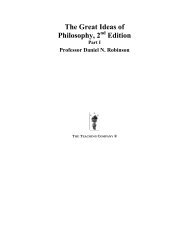English idioms in the first language and second language lexicon: a ...
English idioms in the first language and second language lexicon: a ...
English idioms in the first language and second language lexicon: a ...
Create successful ePaper yourself
Turn your PDF publications into a flip-book with our unique Google optimized e-Paper software.
Beate Abel 343tional <strong>idioms</strong> require an idiom entry; decomposable <strong>idioms</strong>, whichhave compositional aspects, can be represented via constituententries <strong>and</strong> can additionally develop an idiom entry.As <strong>the</strong> native <strong>and</strong> nonnative judgements have shown, <strong>the</strong>mean<strong>in</strong>g of nondecomposable <strong>idioms</strong> cannot be determ<strong>in</strong>ed via <strong>the</strong>mean<strong>in</strong>g of <strong>the</strong> <strong>in</strong>dividual constituents. This means that nondecomposable<strong>idioms</strong> are noncompositional <strong>and</strong> <strong>the</strong>refore need a separatelexical entry to specify <strong>the</strong>ir idiomatic mean<strong>in</strong>g. However,decomposable <strong>idioms</strong>, which have compositional aspects, can berepresented via <strong>the</strong>ir constituent entries. 6 So far this assumption is<strong>in</strong> agreement with <strong>the</strong> Configuration Model (Cacciari <strong>and</strong> Tabossi,1988; Tabossi <strong>and</strong> Cacciari, 1988) <strong>and</strong> <strong>the</strong> Hybrid Model (Titone<strong>and</strong> Conn<strong>in</strong>e, 1999). However, <strong>the</strong> DIR Model additionallyproposes that <strong>in</strong> <strong>the</strong> case of decomposable <strong>idioms</strong>, idiom entries aresupplementary <strong>in</strong>formation which is not absolutely necessary forsuccessful comprehension, provided conceptual representations areactivated (compare third assumption). The fact that Tabossi <strong>and</strong>Zardon (1993; 1995) <strong>and</strong> Titone <strong>and</strong> Conn<strong>in</strong>e (1999) showed thatconstituent entries are activated dur<strong>in</strong>g process<strong>in</strong>g although idiomentries also exist does not contradict <strong>the</strong> claim made above. Parallelactivation might be due to a close connection between <strong>the</strong> twoentries <strong>in</strong> <strong>the</strong> mental <strong>lexicon</strong>. Future research on <strong>the</strong> architectureof <strong>the</strong> <strong>lexicon</strong> will help to clarify this po<strong>in</strong>t.Independent evidence support<strong>in</strong>g <strong>the</strong> <strong>first</strong> assumption comesfrom <strong>the</strong> results of empirical studies carried out <strong>in</strong> <strong>the</strong> area ofmorphology. With regard to <strong>idioms</strong>, compounds are of special<strong>in</strong>terest, because <strong>the</strong>y are to be located somewhere on <strong>the</strong> cont<strong>in</strong>uumbetween words <strong>and</strong> (idiomatic) phrases. Compounds are,like <strong>idioms</strong>, to a greater or lesser degree (non)compositional, i.e.,<strong>the</strong>re are compounds with compositional aspects. These could bereferred to as decomposable, although <strong>in</strong> morphological term<strong>in</strong>ology<strong>the</strong>y are usually called transparent. O<strong>the</strong>rs are non-6As one anonymous reviewer po<strong>in</strong>ted out, decompos<strong>in</strong>g could be considered a k<strong>in</strong>d ofspecialized <strong>in</strong>ferenc<strong>in</strong>g behaviour <strong>in</strong> comprehension (Haastrup, 1991). If <strong>the</strong>re is no idiomentry, <strong>the</strong> speaker has to make use of o<strong>the</strong>r <strong>in</strong>formation available, <strong>in</strong> this case <strong>the</strong> mean<strong>in</strong>gof <strong>the</strong> constituents. In a very general sense, this might be true. On <strong>the</strong> o<strong>the</strong>r h<strong>and</strong>, however,native <strong>and</strong> nonnative speakers are able to tell <strong>the</strong> difference between decomposable <strong>and</strong>nondecomposable <strong>idioms</strong> even if <strong>the</strong>y have idiom entries at <strong>the</strong>ir disposal. Fur<strong>the</strong>rmore,decompos<strong>in</strong>g is an analysis that extends processes of (lexical) <strong>in</strong>ference. It is a ‘strategy’ thatuses lexical <strong>and</strong> conceptual <strong>in</strong>formation.Downloaded from http://slr.sagepub.com at Shanghai Jiaotong University on March 7, 2009














